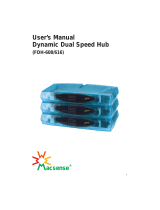Copyright
Copyright © 1998 by this company. All right reserved. No part of this documentation
may be reproduced in any form or by any means or used to make any directive work (
such as translation or transformation ) without permission from Macsense Connectivity,
Inc. . Macsense Connectivity, Inc. reserves the right to revise this documentation and to
make changes in content sometimes without obligation among Macsense Connectivity, Inc.
to provide notification of such revision or change.
FCC Warning
This equipment has been tested and found to comply with the limits for a Class B digi-
tal device, pursuant to Part 15 of the FCC Rules. These limits are designed to provide rea-
sonable protection against harmful interference in a residential installation. This equipment
generates, uses and can radiate radio frequency energy and, if not installed and used in
accordance with the instructions, may cause harmful interference to radio communications.
However, there is no promise that interference will not happen in a particular installation. If
this equipment does cause harmful interference to radio or television reception, which can
be determined by turning the equipment off and on, the user is encouraged to try to correct
the interference by any of the following measures:
¥ Reorient or move the receiving antenna.
¥ Increase the distance between the equipment and receiver.
¥ Connect the equipment into an outlet on a circuit different from the one which the
receiver is connected to.
¥ Consult the dealer or an experienced radio/TV technician for help.
You may use unshielded twisted-pair (UTP) or shielded twisted-pair (STP)cable for RJ-
45 connections.
CE Declaration of Conformance
This equipment complies with the requirements relating to electromagnetic compatibili-
ty, EN 55022/95 Class B. This meets the essential protection requirements of the
European Council Directive 89/336/EEC on the approximation of the laws of the Member
Status relating to electromagnetic compatibility.
You are now cautioned that changes or changes not expressly approved by the party
responsible for compliance could void your authority to operate the equipment.
Trademarks
All companies, brands, and product names are trademarks or registered trademarks of
their respective companies. Specifications are the subject to be changed without prior
notice.
12
















